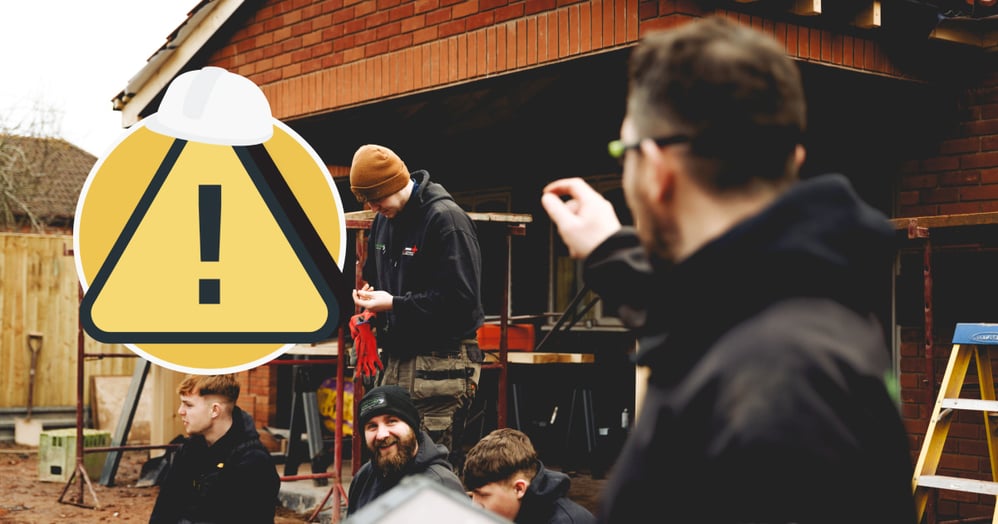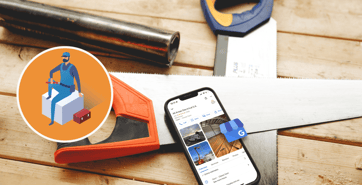Health and Safety in Construction – What You Need To Know
by Team Tradify, February 8, 2023

Table of Contents
No matter your business goals and how you plan on achieving them, the health and safety of yourself, your team, and your customers should always be your number one priority.
Wondering what your staff think about health and safety? Ask them with our free Health & Safety Survey!
Despite plenty of regulations to adhere to, it’s always a good idea to go above and beyond when it comes to health and safety. Not only does this mean that you can be confident that you’re doing your utmost to keep people safe, but your staff will have the peace of mind needed to focus on the task at hand. That means better work and happier staff! Don’t have staff? Well, it’s just as important to keep customers, subcontractors, and other people safe on site too.
There are four main considerations you need to keep in mind when assessing, implementing, and improving health and safety practices in your business:
- 1. Understanding the key risks and how to avoid them
- 2. Ensuring team members are all on the same page
- 3. Complying with the laws and regulations in your country
- 4. Keeping your team compliant too
1. Know the risks and how to avoid them
The construction industry is not well known for its safety. There are many risks on the job that can lead to personal injury or even death, so it's important to take them seriously.
Here are the biggest risks for construction workers while they’re on the job:
Heights
Falling from scaffolding, roofs, windows, ladders, and other high platforms is the biggest risk in construction. To avoid these risks:
- Don’t spend too much time on a high platform - delegate the work between staff and encourage frequent breaks to ensure those in high places stay focused and cautious.
- Use harnesses whenever possible.
- Provide ladder safety training.
- Don’t let anyone in your team try to carry heavy objects alone if they’re on a high platform.
Heavy objects & machinery
Getting trapped or struck by heavy objects and machinery is another big risk. Here are some ideas to keep people safe from these hazards:
- Ban headphones or loud music in areas where these hazards exist. It’s important to hear your surroundings and use caution accordingly.
- Hold regular safety meetings and run through a list of heavy machinery that can be expected on site that day or week.
Electricity
Electrical hazards aren’t reserved for electricians, electrocution is a very real risk for construction workers too. Here’s how to keep out of harm’s way:
- Correct PPE and shock-proof tools are a must, so run equipment checks every day. No PPE or shock-proofs, no getting behind the tools. Keep some extra PPE handy for those that forget.
Dust or chemical inhalation
Because its health consequences are less immediate than other health and safety risks, the danger of dust inhalation can be underestimated. But the fact is that inhalation is one of the most serious risks to construction workers and can lead to silicosis, lung cancer, and other respiratory diseases. Try the following to stay safe:
- Wear appropriate PPE, especially dust or chemical masks.
- Try to ventilate areas where the accumulation of dust or airborne particles can occur.
- Limit exposure to dust or chemical-filled areas.
More hazards to look out for
The hazards above are just the tip of the iceberg when it comes to construction risks. Some other important considerations include:
- Loud noises - this is a little talked about issue in construction and is a leading cause of hearing loss.
- Physical strain - lifting heavy objects or contorting into small crawl spaces for long periods can cause serious physical injury over time.
- Asbestos - while it’s becoming less common to encounter asbestos on site, the risk is still very real. Asbestos exposure can cause lung disease.
2. Keep your team on the same page
While you may have a clear plan in place to avoid health and safety risks on site, your team might not feel the same way. This is why it’s important to check in regularly with your team and create an open forum for health and safety discussion.
The best way to do this is with Toolbox Talks. These are regular meetings held with the sole purpose of sharing health and safety information — identifying hazards (old and new), calling out any health and safety errors that had been made recently, and pointing out objectives for the day or week ahead.
If you need a hand with your Toolbox Talks, we’ve made a free easy-to-use template.
Before you hold one of these meetings, it’s a good idea to gain an understanding of how much your staff know about your business’s health and safety protocols, or if they have any thoughts, concerns, or questions on the matter. It’s really easy to do this, simply download our free Health & Safety Questionnaire and fire it off to your staff.
3. Your legal requirements as a construction business owner
Legal requirements differ by region, but, no matter where you’re based, you can count on them being strict and thorough. Here’s what you need to know based on where you operate:
🇺🇸 United States
If you own a trade business in the US, then you must adhere to the requirements outlined in the Occupational Safety & Health Act (OSHA). Check out our guide to health and safety requirements in the US to see a full breakdown.
🇬🇧 United Kindom
You’ll need to follow the requirements that are stated in the Health and Safety at Work Act 1974. You can take a look at our guide to health and safety in the UK for more info.
🇦🇺 Australia
Legal requirements can differ by state or territory in Australia, so it’s important to see which occupational health and safety requirements apply to you. Check out our guide to health and safety in Australia for a detailed guide to getting it right.
🇳🇿 New Zealand
In New Zealand, you must comply with the requirements laid out in the Health and Safety at Work Act 2015. Our guide to health and safety in New Zealand is a great place to start familiarising yourself with your obligations and responsibilities.
4. Keep your team compliant too
Taking the time to get your team up to speed on the requirements above is a must. This way, if you’re you’re on holiday or have to hop off-site for a while, you can be confident that your company won’t be breaching any rules or regulations.
With all-access Job Notes, Tradify lets you keep your team in the loop from anywhere at no extra charge. In addition, our Job Tracking feature helps you keep tabs on where your staff are and what they’re doing, so you can stay in control and get ahead of risks if you need to.
With Tradify, you can manage a lot more than just health and safety risks. Quoting, invoicing, enquiries, subcontractor management — handle it all with Tradify. Anywhere. Any time. Try us free for 14 days or see us in action during one of our live demo webinars.
Related articles

How To Set Up a Google Business Profile (for Trade Businesses)

Aussie Electrician Reduces Admin Time by 95%

Squeaky Clean Scheduling for Pro Carpet Cleaning
Give Tradify a go for free!
Save 10+ hours/week on business admin with the highest-rated job management software for tradespeople.
With free one-on-one training and phone support, it's never been easier to get started.




